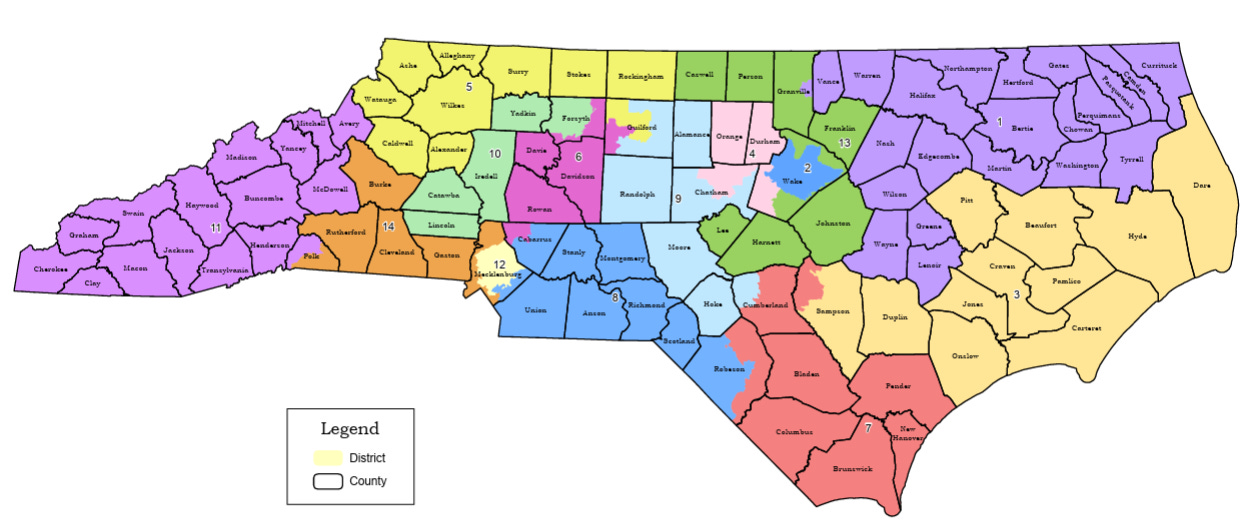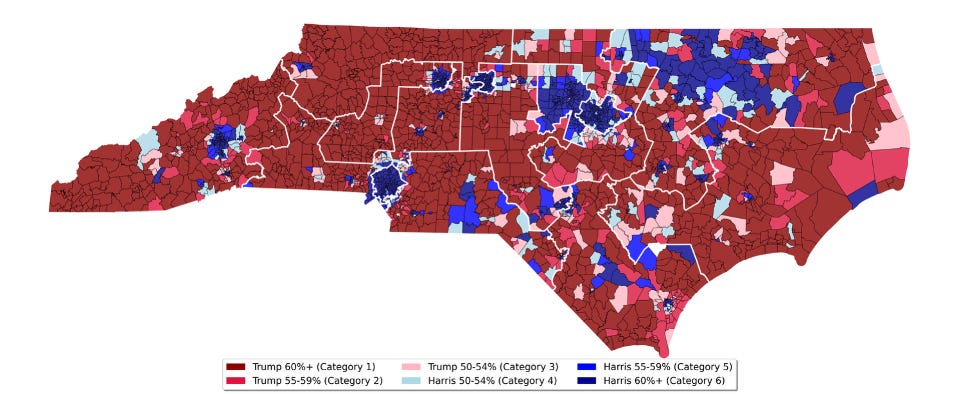By Michael Bitzer
Fall breaks on college campuses are suppose to be quiet ones—students away, faculty getting some rest as well, all with the oncoming rush to the end of the semester looming ahead.
Well, at least on this Monday of Catawba’s fall break, news decided to interrupt that R&R with word that state legislative Republicans would follow the calls of their party leader and redistrict North Carolina’s congressional map to create “at least one” Republican pick up from the Old North State.
The GOP leaders’ announcement focused on trying to build some cushion in next year’s mid-term elections with shifting a map that is currently 10-4 Republican to 11-3. And the likely target will be the First Congressional District, located in the northeastern portion of the state with Democrat Don Davis. It’s a very 50-50 district currently (located in the upper northeastern portion of the state and ironically colored purple in the below map), with Davis having won with 49.5 percent of the vote in 2024.
But in thinking about the current map and the political dynamics at play, I recently created a precinct category map that shows how each of the 2,600 precincts across the state voted in 2024’s presidential election in six categories, with the white lines marking the current congressional boundaries.
Notice in the first district’s band of dark blue precincts (voted for Harris at 60 percent or greater) surrounded by deep reds (voted for Trump at 60 percent or greater). If some of those dark blue precincts were ‘relocated’ into surrounding (and currently) safe GOP districts, while moving some deep red precincts into the first (most likely on the southern straight line border with the 3rd Congressional District), you’d see a quick flip of that district into “likely” GOP status (“likely” is along the lines of 50 to 54 percent GOP based on 2024 presidential election returns).
So, the First makes the most sense to be the most likely target of the GOP redrawing efforts. Shifting out some dark blue precincts and incorporating in dark red precincts would be the easiest way to craft a GOP-likely pickup.
But there’s a possibility (just a possibility at this point) that some might say, “why settle for just one seat?” The most extreme version of a map that I could envision would be to take the very solid Democratic districts (the 2nd over Wake County, the 4th primarily over Durham County, and the 12th over Mecklenburg County) and ‘crack’ the Democratic dark blue precincts into surrounding Republican districts, thereby absorbing the Democratic votes and eliminating the Democratic districts.
This ‘cracking’ was done to Guilford County and Greensboro, splitting that Democratic city into three different congressional districts.
Imagine (as I ask my students to do) taking the 12th Congressional District in Mecklenburg, for example, and cutting it like a pizza, then moving the ‘slices’ into surrounding Republican districts. This would be different from the current ‘donut’ approach of ‘packing’ Democratic precincts (voters) into a district, leaving the surrounding ones much more GOP.
Of course, drawing district lines in a state that is so partisan in its voting patterns (just look at how few lightly shaded precincts there are across the state—less than 15 percent of the precincts) and that is so calcified and rigid in its voting loyalties would render a good map into a total GOP map for Republicans, thus picking up multiple seats.
But even with this clear sorting of North Carolinians into tribalistic political precincts, North Carolina public opinion seems to push against the use of gerrymandering, or the redrawing of districts to favor one group over another. In the June 2025 survey of 1,000 North Carolinians (with a margin of error of +/- 3.56 percent), 84 percent of respondents said that it was an important principle of American democracy that “the way electoral districts are drawn doesn’t consistently favor one political party over the other.”
And within self-identified partisanship, 89 percent of Democrats and 84 percent of Republicans said it was important that gerrymandering not be a principle of American democracy. Eight out of ten self-identified independents agreed.
But one factor is missing from the overall equation: what is the political dynamic like a year from now? Political scientists know that in a mid-term election, presidents and their parties tend to lose seats. And an early forecast by two respected political scientists who analyze election forecasting shows, at this point in time, a potential 28 seat drop among Republicans in the U.S. House, based on the current economic and presidential approval variables.
Another factor: legal challenges filed against whatever map may be passed by North Carolina Republicans in the coming weeks. It would likely be a racial claim, but one N.C. lawsuit has already failed in district court, while another case could potentially further restrict the use of the Voting Rights Act in making such challenges.
All of this is to say: keep your eyes on North Carolina as the nationalized impact of the redistricting wars come to bear on the Tar Heel state—and the state goes through another round of “which congressional district are you in” game yet again (something most long-time NCians have been accustomed to playing).
-------------------
Dr. Michael Bitzer is a professor of politics and history and director of the Center for North Carolina Politics & Public Service at Catawba College. He is the author of Redistricting & Gerrymandering in North Carolina: Battlelines in the Tar Heel State.

